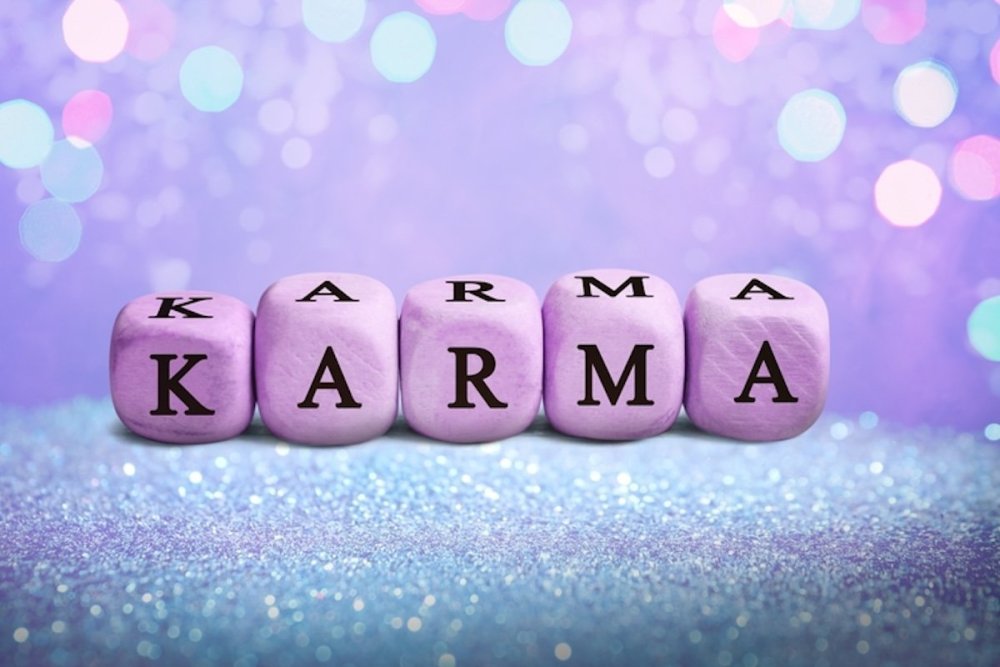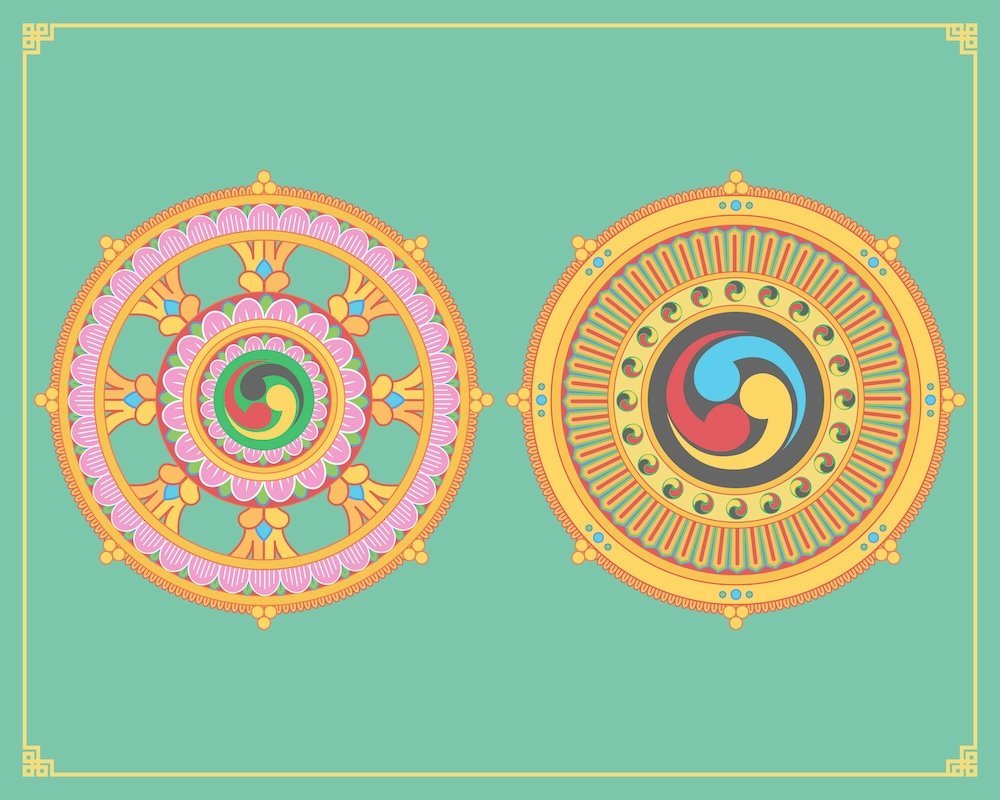The laws of karma say that everything we do in life – good or bad – has consequences: what goes around comes around. Ann Vrlak explores the meaning of karma in buddhism and hinduism and ponders the question: is karma real?
Karma is an interesting notion, isn’t it? It’s actually an Eastern concept that’s become common in Western cultures. It’s understood to mean “what goes around comes around”, or we say someone “has good karma” if things always seem to go their way.
The Eastern meaning of karma, that originated in Hinduism and Buddhism, has a deeper meaning and intent. So, what is karma and how does karma work? Here's an introduction to what karma is and isn’t, and how different religions define it.
What Karma Means
Though karma has various meanings depending on the religion, at its core it means “the law of cause and effect” – that the things we do have consequences for us. If you knowingly lie to someone, for example, it ripples out like a negative wave that sooner or later comes back to you. Or, if you show kindness to a stranger in trouble, something positive will return to you.
RELATED:
- The Power of Kindness: the Ripple Effect of Being Nice
- Human Kindness: Why We Need it More Than Ever
- 7 Ways to Choose Kindness Every Day
What karma is not is a punishment. It is simply a principle of life, religious traditions say, that will help followers lead a harmonious inner and outer life. Is karma real? That’s up to you to decide! Let's consider the religious and social value of believing it is.
Different Religions See Karma a Bit Differently
Let's look a bit more in depth at how two major Eastern religions – buddhism and hinduism – integrate karma into their teachings.
1. Hinduism
What if your actions shaped not only your current life, but your next life as well? Hinduism takes a long view of human existence, that our lives are an ongoing cycle of life, death, and rebirth. So, harmful actions create what is called “karmic debt” – a burden that you carry into your next life.
Religions that believe in karma say this explains why some people have life patterns that aren’t easily explained by their life circumstances. When they were born, the effects of their past negative actions came with them.

Karma: what goes around, comes around
But, the good news is, the opposite is true for a person who lives an honest, moral life. They do not carry a lot of karma into their next life to be “worked out.” Their time in the cycle of life is shorter than someone who carries a heavy karmic debt across many lives or “incarnations”.
There are also different types of karma in Hinduism, and all are connected closely to the concept of dharma. You’ll see karmic concepts in Jainism, Sikhism, and some New Age philosophies, too.
2. Buddhism
Like Hinduism, Buddhism frames karma simply as consequences of intentional action, not punishment. Buddhism teaches than intention is everything; that the quality of mind behind your actions determines the karmic effects.
RELATED: 33 Karma Quotes on Justice, Relationships, & More
In part, this speaks to unintentional harms you cause that do not affect your karma, but knowingly acting in a way that harms others or even yourself creates karma in the form of mental and moral consequences.
“Though karma has various meanings depending on the religion, at its core it means “the law of cause and effect” – what goes around comes around.”
The Buddha left believers a comprehensive roadmap to follow. In the Eightfold Path and the Five Precepts, he clearly describes actions that create positive vs negative karma.
Buddhism also shares the Hindu understanding that karma affects the cycle of rebirth. Someone with a dense karmic debt, Buddhists believe, will be reborn again and again until they clear their karma through moral living.
And what if a person eventually achieves enlightenment? They experience nirvana and are freed from the karmic cycle.
Dharma vs karma
A related concept in both Buddhism and Hinduism is dharma. Dharma is each person’s ethical path through life, as defined by their chosen religion. It explains how karma works: it is the result of how well a person follows their path.
Dharma in Hinduism is a form of social moral code that governs individual behaviour. It describes a life that values duty and religious observance. When you stray from your dharma, you create negative karma.

Karma helps you lead a harmonious inner and outer life
Buddhism, on the other hand, grounds dharma directly in the teachings of the Buddha. Specifically, dharma refers to the fundamental laws of nature that all beings are subject to. It is less concerned with the social definition of dharma and more with the need to live in harmony with natural law to create positive karma.
In both religions, it is not a question of dharma vs karma, but dharma and karma. Together, these principles show followers how to fulfil their spiritual responsibility.
How Does Karma Work?
One of the best metaphors for karma is planting seeds. Karma doesn’t have an immediate result, but takes root and spreads throughout a person’s life or lifetimes.
Picture a beautiful garden where you plant 100 tulip bulbs, rather than just one. And you keep the garden watered, pull the weeds and nourish it with nutrients that help it thrive.
“One of the best metaphors for karma is planting seeds. Karma doesn’t have an immediate result, but takes root and spreads in a person’s life or lifetimes.”
Positive karma is like that. Your acts, your intentions, your attention all help your good actions take root and grow. And you can imagine another garden that becomes overgrown with weeds through inattention or active harm.
Karma is a complex, interwoven process where – sooner or later – you “reap what you sow.”
Karma Symbols
You may have seen a karma symbol without knowing it! The most common are the endless knot and the wheel of samsara.

Karma symbols include the wheel of samsara (left)
These symbols are used in religious texts and artwork as a reminder of the principles of karma. The elaborate karma symbol designs suggest the interconnectedness and cyclical nature of all life. As objects of contemplation, these symbols are believed to expand a person’s ability to grasp the complexity and scope of life.
OK, but is Karma Real?
Of course, there is no scientific way to prove that karma – or the cycle of rebirth that it fuels – exists. It is a core concept that these religions believe helps us to understand this larger view of our lives. Karma helps Hindus and Buddhists to use the law of karma to guide their behaviour toward other beings.
Within psychology, karma is often seen as a common sense idea. If you treat others poorly, you may be treated poorly in return and vice versa. But, karma encompasses the idea of self-harm, too. When you harm others, you harm yourself because you have acted against social or universal principles.
“There is no scientific way to prove that karma exists. Within psychology, karma is often seen as a common sense idea. If you treat others poorly, you may be treated poorly in return.”
Whether karma is real or not, it is a deeply powerful idea that shapes the lives of millions of people. It puts individualism in a different light. Our personal actions and even our thoughts count. They affect us – and everyone around us – much more profoundly than we may think.
Takeaway: What Goes Around Comes Around
Another way to understand karma is as a moral or spiritual compass. Particularly in modern living, there are so many choices and decisions to make every day. How do you know what to do and where to go?
Karma points the way to living according to your dharma. Whether karma is “real” or not, it encourages all of us to believe that our personal actions matter beyond the moment and beyond our own lives. It’s a guide to living with positive intention that is aligned with an expanded view of our humanity. ●
Images: shutterstock/ADragan, shutterstock/mr_owlman
happiness.com | The fine art of being: learn, practise, share
Are you a happiness.com member? Sign up for free now to:
■ enjoy our happiness magazine with practical life tips
■ share and support others in our happiness forum
Gratitude | Acceptance | Altruism | Conscious Living | Kindness
Written by Ann Vrlak
 Ann Vrlak is Founder of OneSelf Meditation and a meditation practitioner for over 25 years. She’s a Certified Meditation Teacher for adults and for children (the best job ever!). She loves to share how the perspective and practice of meditation can support people with their everyday stresses and on their journey of self-discovery.
Ann Vrlak is Founder of OneSelf Meditation and a meditation practitioner for over 25 years. She’s a Certified Meditation Teacher for adults and for children (the best job ever!). She loves to share how the perspective and practice of meditation can support people with their everyday stresses and on their journey of self-discovery.

Join the conversation
You are posting as a guest. If you have an account, sign in now to post with your account.
There are no comments to display.